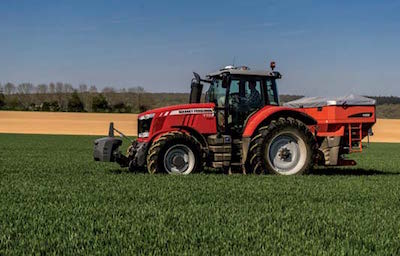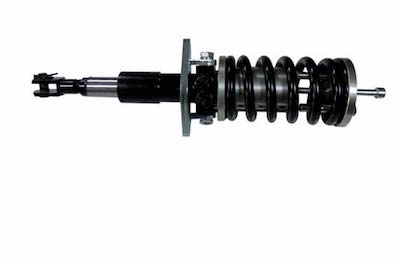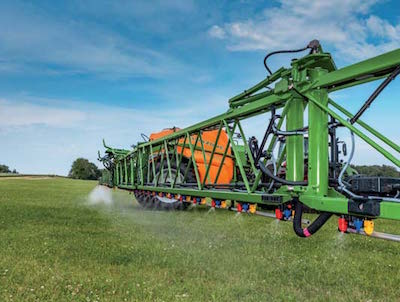Along with their Gold Medal and Silver Medal award presentations, SIMA 2017, the Paris International Agribusiness Show that will be held Feb. 26 – Mar. 2, also announced several “Special Mention” awards as part of the Innovation Award program to farm equipment manufacturers who introduced new innovations in the past year. Part 1 of the awards is presented here.
The award winners were selected by a panel of 25 experts from France, and headed up by Jean-Marc Bournigal, chairman of the French National Research Institute of Science and Technology for Environment and Agriculture.
Special Mention: AGCO/Massey Ferguson Dynamic Top Link Control of Upper Link Spindle
The Massey Ferguson Dynamic Top-Link Control (DTLC) system automatically adjusts the upper link spindle to preserve the attachment’s position relative to the ground. This function improves toolkit efficiency, which is frustrated by variations in the tractor’s tilt due to the slope, or the variable load of spreading equipment.
Continuous variations in the tractor’s tilt change the equipment’s position and therefore their working quality. The tool’s adjustment must be continually watched and adjusted to maintain the optimal position. Keeping a close eye on things is critical with equipment like manure spreaders, where the angle of tilt influences distribution considerably. Indeed, a few degrees’ change in the tilt of a manure spreader can change the breadth of the spreading, which results in over or under application.
The objective of the incline sensors, placed on the attachment and on the tractor, is to dynamically keep the attachment parallel to the ground. The ground reading is indicated by the tractor. Since it may approach a gradient, the speed indicator and the setting of the tractor-header wheelbase indicates the correction that must be made to keep the equipment parallel or at a constant angle relative to the ground.
The most common practice in soil working equipment is to have the header rest on in-soil rollers or wheels and place the upper link over an oblong hole. Ground tracking is perfect, but the tractor doesn’t get most of the load transfers it’s supposed to, so grip is compromised and wheel spin could result.
The upper link spindle is electronically controlled, so it is constantly adjusted, promoting optimal load transfer. Setting accuracy of the Massey Ferguson Dynamic Top-Link Control system is more precise than settings done manually; users only have to focus on their work.
Special Mention: Agriest’s Agri-Power Dual-Function Hydraulic Braking Jack
The new Agri-Power dual-function hydraulic braking jack integrates both dynamic braking (traditional hydraulic braking), activated by the brake pedal, and the hand brake (parking or emergency brake).
To perform this dual function, the Agri-Power braking jack has two hydraulic chambers. Pressing the tractor element’s brake pedal pressurizes the jack’s first chamber. At the same time, the second chamber also pressurizes, compressing the spring. Releasing the brake pedal releases the pressure in the first hydraulic chamber: then the jack is in the dynamic braking phase.
A check valve keeps the second hydraulic chamber pressurized. The jack moves into the parking/emergency brake phase by releasing the hydraulic pressure from the second chamber into the first. This pressure is released by activating the lever of the hydraulic valve integrated in the circuit. The spring mechanically holds the jack in its parking/emergency brake function.
This dual-function hydraulic brake can be mounted on any kind of equipment used for transport, soil working, etc. So it’s very easy for European manufacturers to adapt to the hydraulic braking market, particularly because working pressure is identical to that of a hydraulic circuit in traditional braking. On equipment fitted with the air brake reservoir holder, it is quick and easy to assemble. With its dual function, there’s no need for the frequently complicated installation of the rods or cables of a hand brake or parking brake.
Power variation can be given to the parking brake by adjusting the spring tension, and the parking brake can be released by hand if the equipment is not coupled with the hydraulics of a tractor unit.
Special Mention: Amazone’s HeightSelect System for Controlling Ramp Height Based on Nozzle Heads
The HeightSelect system is an interface between the “AmaSelect” electrically controlled nozzle body and the “Distance Control” automatic ramp height control system.
The HeightSelect system can be used to program a spraying height for each nozzle head integrated in the Ama-Select nozzle body. Since each nozzle head can require different working heights according to its features, this new automation maintains high distribution quality of the active agents being sprayed whenever it’s time to change the nozzle head. Therefore, as soon as the working nozzle head is adjusted to spraying conditions, either by the user or automatically, the ramp height will be changed automatically so as to maintain perfect spraying quality.
In particular, for combating skids, because with the AmaSelect system, a single tap on the Isobus terminal changes the spacing between nozzle heads from 50-25 cm (moving from one active nozzle head for every two to all active nozzle heads). This change reduces the height of the spraying while it’s ongoing, keeping the spray droplets from being caught in the wind and drifting.
With the HeightSelect system, a change to the spacing between nozzle heads, from 50-25 cm, will automatically result in changing the spray height to a value programmed in centimeters, which reduces drift while maintaining perfect distribution of the active agent being sprayed.
Depending on the application environment, this system also secures spraying when changing nozzle heads or altering the gap between nozzle heads, to position them at a height where the active agents are kept well distributed across the working breadth.
Special Mention: ARVALIS - INSTITUT DU VEGETAL Taméo Decision-Support Tool Combining Agronomic and Meteorological Models
ARVALIS – Institut du v.g.tal and M.t.o–France have merged their farmer-focused agricultural and meteorological expertise in Taméo, an online source of real-time advice for coordinating crops and performing tasks in each plot on the farm.
In real-time, users can track the dates on which the crop stages are forecast to appear and the risk trend for the appearance of diseases. They can also identify the best times for fertilizing, weeding or protecting the crop. There is also a detailed weather section for anticipating and scheduling workstreams, guiding famers in their day-to-day decisions.
This means farmers are better prepared for the risks of weather hazards and other yearly variations, making the right decision at the right time. Taméo. makes crop management more successful in terms of yield, profitability and the environment, combining digital innovation with forecast, climate and agricultural modeling.
Providing both agricultural and meteorological models, Taméo is the first complete multi-service tool for tracking and managing parcels in real-time. Taméo is available for tablet, PC and smartphone, and provides up-to-date answers to users’ questions in a few clicks. Taméo 1.0 is for common winter wheat, and over time it will expand to include the other varieties being researched by ARVALIS (other grains, maize, potatoes, linseed, etc.). Taméo is also innovative in terms of the method chosen to design it: a group of farmers belonging to five ARVALIS regional committees advised the project team in their decisions and discussions over which features to develop. That means it’s a tool built by and for farmers, to best meet its users’ needs and expectations.
Special Mention: Claas’ Shredlage Corn Cracker for Shredded Silage
Lot-feeding techniques, specifically cut length, mean that manufacturers must upgrade their forage harvesters, primarily the cracking tool. Shredded silage is a new lot-feeding technique that seems promising. Instead of cutting the maize into short fibers (10-18 mm), where it is very difficult to crack the kernels, you get silage of fully shredded long fibers (26-30 mm) and powdered kernels.
The straw in the ration can be removed and replaced with nutritive fiber from the maize. This has implications for farming in terms of livestock feeding practices. Studies have shown promising results for dairy cows: an 8-20% increase in rumen, a slight increase in pH, and an increase in starch availability from the previous <60% to >70%.
On top of these positive effects on the animals’ health and on the ruminants’ chewing, there is also a feed cost reduction: a greater volume of digestible crude fiber in the silage. Claas’ Shredlage cracker rollers are designed specifically to meet the special needs of this new type of lot feeding. The Shredlage cracker is composed of two 250-mm rollers, one roller with 110 teeth and the second with 145 teeth. There is a 50% speed differential between these two rollers. These cracker rollers, with counter-directional helical grooves, chop up the cob fragments completely and crush the kernels to split them thoroughly. The stalk fragments are also shredded longitudinally into strings and their bark layer is peeled. The maize is simultaneously scraped and stripped while passing through the rollers.






Post a comment
Report Abusive Comment